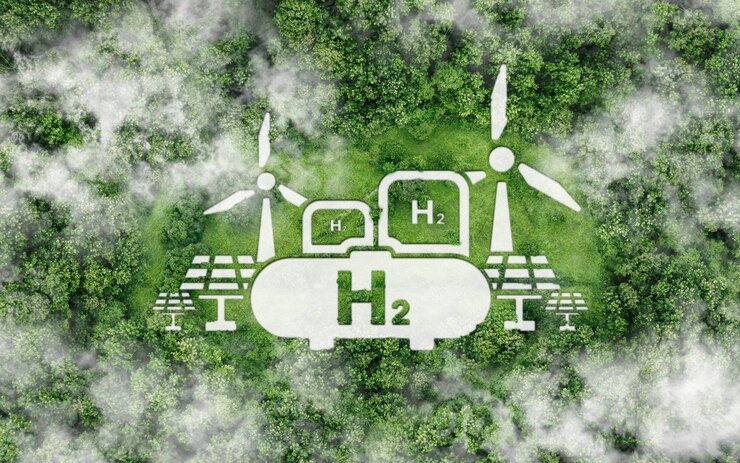In the global race to reduce carbon emissions and shift to renewable energy sources, green hydrogen is emerging as a critical player in the clean energy transition. This revolutionary fuel offers the potential to decarbonize sectors that are difficult to electrify, such as heavy industries and transportation. As governments, industries, and businesses focus on sustainability, green hydrogen is being hailed as a key solution for achieving a carbon-free future.
What is Green Hydrogen?
Green hydrogen is hydrogen that is produced using renewable energy sources like wind, solar, and hydropower, rather than fossil fuels. The process of making green hydrogen involves electrolysis, which splits water molecules into hydrogen and oxygen using electricity derived from renewable sources. Unlike traditional hydrogen production methods, which rely on natural gas and emit harmful CO2, green hydrogen is a completely clean process, making it an essential component of the renewable energy ecosystem.
Electrolysis technology is central to the production of green hydrogen, and its efficiency is continually improving as more research and innovation drive down costs. By using renewable energy to produce hydrogen, the overall carbon footprint is dramatically reduced, making green hydrogen a truly sustainable fuel.
How Does Green Hydrogen Benefit the Environment?
The environmental benefits of green hydrogen are significant. As the world continues to confront climate change, reducing greenhouse gas emissions is critical. By replacing fossil fuels in industries like steel manufacturing, chemical production, and even heavy-duty transport, green hydrogen can help reduce global CO2 emissions. It offers a clean alternative to fuels like coal, oil, and natural gas, which are the primary contributors to air pollution and climate change.
Unlike hydrogen produced from fossil fuels (known as gray or blue hydrogen), green hydrogen does not release harmful carbon dioxide. When burned or used as a fuel, it only emits water vapor, making it an ideal candidate for industries aiming to reduce their carbon footprints.
Green Hydrogen in the Energy Transition
One of the most exciting aspects of green hydrogen is its potential to revolutionize energy systems. It can be stored and transported more easily than electricity, making it ideal for long-term energy storage solutions. For example, excess energy produced from renewable sources during peak production times (such as midday when solar energy is abundant) can be used to produce hydrogen, which can be stored and used later when energy demand is high or when renewable generation is low.
Also, green hydrogen can be used in fuel cells to power vehicles, which is especially beneficial for sectors where electric batteries are not as efficient, such as long-haul trucking, shipping, and aviation. This ability to replace fossil fuels in hard-to-decarbonize sectors makes green hydrogen a vital tool for achieving global sustainability goals.
The Role of Green Hydrogen in Decarbonizing Industries
Industries such as steel, cement, and chemicals account for a significant portion of global carbon emissions. Green hydrogen offers a clean alternative to the fossil fuels traditionally used in these energy-intensive sectors. In the steel industry, for example, green hydrogen can be used to replace coke in the reduction process, resulting in a zero-emissions steel production process. Similarly, in the chemical industry, green hydrogen can replace natural gas for hydrogenation and other chemical processes.
Challenges and the Road Ahead
While green hydrogen holds immense promise, there are several challenges to overcome before it can be scaled up globally. The biggest hurdle is the current cost of production. Electrolysis is still relatively expensive, and the infrastructure for large-scale production and storage of green hydrogen is underdeveloped. However, as technological advancements and economies of scale reduce costs, green hydrogen is expected to become more affordable.
Additionally, governments and private companies must invest in building the necessary infrastructure, such as hydrogen production plants, distribution networks, and refueling stations, to ensure the widespread adoption of green hydrogen. Collaboration between governments, industries, and energy companies will be crucial in driving the development of the hydrogen economy.
Green hydrogen represents a significant opportunity for the world to transition to a sustainable energy future. With its ability to decarbonize hard-to-electrify sectors and provide clean energy storage solutions, it has the potential to be a game-changer in the fight against climate change. As technological advancements continue and investments in infrastructure grow, green hydrogen could become a cornerstone of the global clean energy landscape, helping to create a carbon-free future.
By focusing on green hydrogen production and adoption, we can make substantial progress toward achieving sustainability goals and reducing our reliance on fossil fuels. The future of energy is green, and green hydrogen is leading the way.




